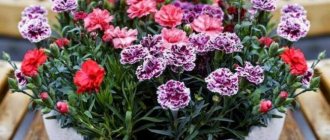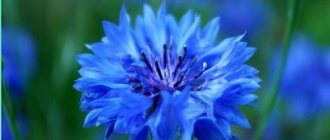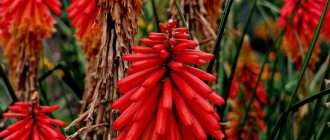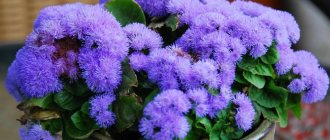Adonis (adonis, starodobka) belongs to the ranunculaceae family. There are about 45 species of herbaceous annual and perennial plants in this genus. Their natural habitat is temperate climate areas in Asia and Europe. According to legend, The name of the flower comes from the son of the Cypriot king Adonis - he died while hunting from the fangs of a boar, and his blood painted the petals scarlet. An alternative version states that the plant is named after the Assyrian god Adon.
In the material we will provide a detailed description and photo of the adonis flower, give recommendations for planting and growing it, and outline the beneficial properties of the plant.
Description and features of Adonis
Adonis grows in the steppes of Europe with large grass cover, sometimes found in Germany, Switzerland (very rarely, almost disappeared). He prefers black soil, open places, and small elevations. It can grow in some areas on rocks (Crimea), sometimes on the edge or on the lawns of birch groves or oak forests. It is found in Western Siberia, Altai, and the Caucasus, where its flowering period will only last until mid-June.
Poets compare this plant with the sun and spring. In botany, the description will not be so beautiful. Its single lemon flower (4-8 cm) is located at the crown of the stem. In summer, spherical fruits (20 mm) and nuts (30-40 pieces) with a hooked nose ripen. Leaves are brown. The lower ones resemble scales, the others are sessile, divided into narrow lobules. The straight shoot (15-30 cm) is smooth and round in shape. The vertical root is small with shoots, brownish in color.
The plant and its parts are considered poisonous. The Red Book in Russia includes Adonis vernalis for its protection.
It is grown industrially for use in pharmaceutical compositions or for the preparation of medicines. When independently collecting in nature, they do it carefully and selectively (3 stems per m2 must not be touched).
Adonis toxicity
It is important to know! Adonis has no natural enemies, it is practically not affected by parasitic insects, and the plant is famous for its good resistance to the most famous garden ailments. It is important to note that such resistance is not a simple feature - the Adonis plant is very poisonous, and all its parts contain poison. When working with adonis, you must take precautions, and when dividing the plant, you must wear gloves.
4 Rating 4.00 (2 Votes)
- Back
- Forward
Types and varieties of Adonis
Adonis differs by type: annual and perennial.
Annuals
The growing season of such a plant lasts one season.
Summer (aestivalis)
Other names are also known: ember in the fire or pheasant's eye. Its smooth stems (10-50 cm) with grooves can be different: branched, straight or simple. Leaves, consisting of two or three lobes, are of the following types: sessile at the top, petiolate at the bottom. Flower size 2-3 cm. Red perianth with a dark central spot. The flowering period is all summer.
Autumn (annua)
Sometimes called Adonis annua. Grows up to 30 cm. The leaves are thin, cut in an alternate arrangement. The flowers are light yellow or deep red (1.5 cm), closed at the top. Their central part is dark. Cultivated artificially since 1596.
Perennials
For several years they grow in one place and do not change their properties. They have periods of development and rest.
Volzhsky (volgensis)
The inflorescence is lemon and the sepals are purple. There are few shoots from the thick root. Height 30 cm. It begins to branch from half the stem. Before the first inflorescence appears, there is frequent pubescence on the leaves and stems, then it thins out. The cut leaf curls towards the ground.
Amur (amurensis)
Grows in the Far East. The first to appear are yellowish-golden large flowers (5 cm). Then feathery leaves with petioles. During the blooming period, the plant's growth is 12 cm, later 35. It belongs to the forest species, flowering lasts almost 20 days. Based on it, many varieties with different shades have been bred.
| Variety | Flowers |
| Ben Ten | Velvet white. |
| Sandanzaki | Yellow, protective-colored petals in the middle, semi-fluffy. |
| Hinomoto | The front part is protective bronze, the lower part is coral. |
| Pleniflora | Straw with greenery, shaggy. |
| Ramosa | Red-chestnut, fluffy. |
Siberian (sibirica)
Rich golden (6 cm) flower. Grows up to 60 cm, leaves are pinnately divided. Blooms in late spring or June.
Fluffy (villosa)
For growth, it chooses the edges of birch groves or flat steppe. It has single, densely pubescent stems (15 cm). First, lemon flowers appear, then triangular or oval-shaped leaves begin to grow. During this period, the pubescence decreases, and the height reaches 30 cm.
Golden (chrysocyathus)
A very rare flower, included in the International Red Book. Healthy and highly valued in design.
Turkestan (turkestanicus)
On one bush there are simultaneously ovaries, buds and flowers (4-6 cm). The color of the petals of the inflorescence is of two shades: the outer part is light blue, the inner part is orange-yellow. The above-ground parts of the medicinal plant are covered with curly hairs.
Mongolian (mongolica)
Typically grows in unused pastures. The bush consists of 30 shoots. The white flower (5 cm) blooms first. Sepals are lettuce with a lilac tint. The leaves are sessile in the middle, the lower ones are reduced.
Spring (vernalis)
Artificial breeding of this species began in the 16th century for decorative and medicinal purposes. A thick, small rhizome produces many branched brown shoots. During the flowering period, the height is 5-20 cm, after 40-60. The foliage is finger-like, cut into narrow lobes. Yellow flowers (7 cm) consist of 12-20 glossy petals, which appear at 4-6 years of age in April.
general description
Adonis is grown as a perennial or annual. Almost all of its species grow into low but rather lush bushes. The stems do not exceed a height of 60 cm, the leaves consist of many narrow finger-like lobes. The flowers are bright yellow or scarlet and resemble daisies in appearance. The diameter of the open bud varies between 4-6 cm, the number of petals is from 10 to 20 pieces. Flowering occurs from April to June - it all depends on the species and natural conditions.
The fruits of the plant are leaflets containing wrinkled seeds (up to 30 pieces) with a straight or curved edge. All parts of the plant are poisonous, but this fact does not prevent it from being used for medicinal purposes - we will talk more about this property of the plant at the end of the material.
Adonis prefers sunny areas and partial shade, the soil is light and fertile. The plant does not tolerate transplantation; it can grow in one place for up to 20 years.
Growing Adonis from seeds
Sowing seeds is slightly different for annuals and perennials. Annuals are planted in the fall (November) in the garden to a depth of 1-2 cm. Germination may persist for a short time, so it is better to use recently collected ones. Store-bought seeds are sown in a greenhouse in the spring.
Perennials are planted in containers in the fall and then placed in a cool place. In winter, if there is snow, they are placed in a snowdrift.
The best seeds can be obtained from plants that are 6-7 years old.
It is advisable to prepare the soil for sowing by mixing sand, turf soil and manure in a ratio of 2:1:1. The first shoots usually appear after the air warms up and reaches +20 °C. However, there are seeds that may take a whole year to germinate.
Seedlings need bright light, but it must be diffused and must be protected from direct rays. Irrigation and careful loosening are performed daily. The seedlings are thinned out, leaving a distance of 15-20 cm.
If there is little time left before the transplant, it is better not to do this.
Features of cultivation
The plant loves warm, sunny and protected from the wind.
Calcareous, well-drained sandy-gravel soils with moderate nutrient content are optimal (though they also tolerate barren areas). This is a perennial perennial plant that, under favorable conditions, can grow in one place even for several decades.
Grows well in any regular garden soil that is not too heavy. Prefers moist, well-drained soil in sun or partial shade.
The plant is quite easy to grow, although it does have some soil requirements. Very frost-resistant and does not require shelter. It can be grown for many years in one place.
Propagated by dividing large clumps of plants after flowering in June or August.
Plant propagation by dividing a mature plant as soon as it flowers. It can be propagated from seeds sown immediately after collection, since the seeds quickly lose their viability. Plants obtained from seeds bloom only after 3-4 years.
Transplanting Adonis seedlings into open ground
Caring for and planting plants in open ground is a simple procedure. Usually strong and already grown sprouts are planted. Depending on when the seeds sprout, the time of transplantation is determined. It must be remembered that in order for a flower to winter safely, it needs to take root well, and this takes 4 months.
A great place in the garden for Adonis would be one where there is plenty of sunlight in the morning and shade in the afternoon. For abundant flowering, the soil must contain a lot of fertilizers and lime, acidity 7.0-7.5 pH. The distance between seedlings is left 25-30 cm. The prepared hole must be deep enough for the root so that it does not bend. After planting, water and cover. In the first year after, it usually does not bloom due to its slow development.
Use of spring Adonis: recipes
Let's list the most common adonis-based products.
Important! Before use, consult your doctor and be sure to do an allergy test!
Adonis decoction
In an enamel bowl 1 tbsp. pour a spoonful of crushed adonis into a glass of boiling water. Leave covered for 20–25 minutes. Take the decoction 3 times a day, 1 tbsp. spoon.
Adonis alcohol tincture
The tincture is prepared for 14 days. To prepare it you need:
- 10 tbsp. spoons of vodka;
- 1 tbsp. spoon of crushed adonis.
This is an excellent sleeping pill and sedative. Take it in the form of drops, the maximum dose per day is 20 drops:
- at night before bedtime;
- divide into 3 doses of 5-6 drops.
Water tincture of adonis
Prepare this infusion by pouring 2 tbsp. spoons of herbs 250 ml of boiling water. Leave for 30 minutes. Drink 2 teaspoons three times a day.
Adonis tea
Pour a tablespoon of herbs into 2 cups of boiling water and leave until it cools. Take 1 spoon once an hour.
Preparation of Adonis and storage
Medicinal raw materials are prepared in the spring. Immediately after cutting (the plant cannot be pulled out by the roots so as not to destroy the flower), the material is dried.
It is better to use special installations that allow you to quickly dry the material .
Store adonis in a paper bag or fabric bag in a place protected from sunlight. Adonis retains its qualities for 3 years.
Important! The herb should be stored separately from other medicinal preparations.
Caring for Adonis in the garden
Adonis is an unpretentious plant, so it does not require special care. The following procedures must be carried out:
- regular watering, preventing both drying out and stagnation of moisture;
- periodic loosening to ensure access of air and water to the roots;
- regular application of fertilizers (complex, manure) before flowering and at the end of summer;
- Blooming inflorescences are not picked during the first 2 years so as not to damage the renewal buds;
- shelter for the winter.
Adonis after flowering
Collecting Adonis seeds
It is recommended to start collecting seed material at a time when the seeds are still a little ripe. Storage is a waste of time, which means they need to be mixed with moistened sand and planted in the ground.
Preparing Adonis for winter
Adonis is a frost-resistant plant and there is no need to provide it with shelter when cold weather sets in. But for young seedlings you will need peat for insulation and coniferous spruce branches. Next season they will no longer need to be covered.
Adonis Reproduction
The plant is propagated in two ways: seedlings and dividing the bush. The first option is growing from seeds. The second can be applied to those bushes that are 5 years old or more. This is usually done in early autumn. Carefully dig up the bush and tear it into several parts so that each one contains a root and at least 2 buds. It is advisable to leave the parts large to facilitate the rooting process. The cut site is disinfected and immediately planted.
Caring for them is the same as for young seedlings. If flowers appear on such a bush, they must be carefully removed. The plant should take root well in its new location before the onset of cold weather.
Reproduction by dividing the bush
Adonis can also be propagated by dividing a mature bush that is at least 5 years old. It is advisable to carry out this work at the end of August or beginning of September. If propagation by division is carried out in the spring, then it is recommended to do this before active growth of the plant begins.
The algorithm of actions is as follows:
- Carefully dig up the bush.
- Use a sharp knife to cut it into pieces.
- Leave a few roots and buds in each bush that you separate.
- Lubricate the cut areas with a disinfectant.
- Plant in the ground, ensuring the hole is deep enough so that the roots do not bend.
- It is better to divide the bush into large parts, since small sections are difficult to take, are more susceptible to diseases and may simply die.
Caring for plants after division is no different from caring for seedlings. The advantage of the method is the possibility of flowering in the first year after planting.
It is better to carefully remove flowers on a young bush. This will give him the strength to grow quickly.
Adonis flowers are the best decoration for an alpine hill or border along a path. They go well with primroses and violets. In addition to its amazing beauty, many species of this plant are used in traditional medicine recipes to stabilize the cardiovascular and nervous system.
Mr. Summer resident recommends: medicinal properties of Adonis vernalis
Of all the types of Adonis, the spring one has known medicinal properties. It contains cardiac glycosides, vitamin C, Mg, K, Ca, Mg, Fe salts and tannins. They determine the use of the plant in folk and official medicine:
- Circulatory disorders, nervous system disorders, epilepsy, hypertension, etc. Improves heart function, blood pressure normalizes, shortness of breath and swelling of the legs decreases.
- Kidney diseases. As a diuretic for urolithiasis.
- Whooping cough, chronic bronchitis. Has a depressing effect on the cough center.
- Joint pain, rheumatism.
- Glaucoma, hepatitis.
Decoctions, infusions, teas and alcohol tinctures are prepared from it. The combined use of adonis with other medicinal plants has proven well. Medicinal mixtures are prepared for kidney diseases, hypertension, and in the complex treatment of hepatitis. In medicine, Adonis is included in some types of tablets (Adonis-bromine) and mixtures (Bekhterev), homeopathic preparations.
Medicinal properties and contraindications
Adonis vernalis has the most striking . The stems of the flower and its flowering part are harvested.
The high concentration of useful substances and their unique composition is a simple answer to why spring adonis has been used in folk medicine since ancient times.
For heart disease
The use of drugs based on Adonis vernalis normalizes cardiac activity, improves the condition of blood vessels and the circulatory system as a whole .
For diseases of the nervous system
Medicines based on Adonis vernalis are used to reduce nervous excitability, anxiety conditions and chronic insomnia .
Contraindications
In addition to its unique medicinal properties, adonis also has serious contraindications for use.
It is prohibited to take medications based on Adonis vernalis:
- during pregnancy and lactation;
- for acute gastrointestinal diseases (ulcers, gastritis);
- hypertension will be a 100% contraindication;
- children under 3 years of age;
- high level of blood clotting.
Description of the plant Adonis or Adonis
The genus Adonis, which has about 30 species, belongs to the Ranunculaceae family of flowering plants. Members of the genus Adonis are generally short-growing plants, although some species can reach 50 cm in height. Its Latin name comes from a Greek myth and was given in honor of the son of the Cypriot king. There are from 2 to 4 dozen varieties of this herbaceous plant for open ground, which are divided into annual and perennial species.
Photo of an annual flower - Adonis summer.
It has an erect, branched stem with soft, pale fern-like leaves, finely divided.
In early spring, the plant blooms small, single, crimson-colored flowers, similar to Ranunculus. The black anthers and stamens create a beautiful contrast with the red petals and make the flowers even more attractive. The plant begins to bloom in the spring, and by July the seeds are ripe and ready for pollination, which mainly occurs with the help of beetles, flies and bees. When the sun shines, the flower heads tilt towards it.
You might be interested
Decorative liana Ipomoea: cultivation and use in garden design
Red perennials: the best plants to grow in the garden
Perennial shade-loving flowers and plants for the garden: a selection of the best plants
Preparing for winter
Adonis is a frost-resistant plant, so it does not need shelter. Young seedlings need to be covered. Peat, hay, and foam are used as shelter. Can be covered with spruce branches. After the plant gets stronger (about a year), it no longer needs shelter.
Adonis is a beautiful flower that is of great importance in medicine and landscaping. By combining adonis with other flowers, you can create delightful compositions.
Diseases and pests
Adonis is a poisonous plant and is practically not damaged by pests. The roots and leaves of the flower are not edible; pests simply crush it. Even Adonis seeds are not attacked by insects. Also, the plant practically does not suffer from fungi and infections.
Among the diseases, two common ailments are:
- gray rot. Occurs due to standing moisture. The root system begins to rot. The leaves become covered with a gray coating, begin to dry out and fall off. The affected part is carefully cut off, the cut areas are treated with wood ash;
- fusarium (fungal disease). The plant should be treated with benomyl (foundazol).
Medicinal properties of Adonis
You can grow adonis not only for aesthetic pleasure, but also for medicinal purposes. The most common are cardiovascular diseases. The leaves and tops of Adonis contain a number of bioactive compounds, including cardioactive glycosides, which are beneficial for the heart. Plant parts are dried and made into extracts or tinctures, the main purpose of which is to regulate the heartbeat. But don't even think about using this herb to make your own heart medicine. One of the side effects of internal use of Adonis is sudden cardiac paralysis. Treatment requires either skill or prior consultation with a doctor.











